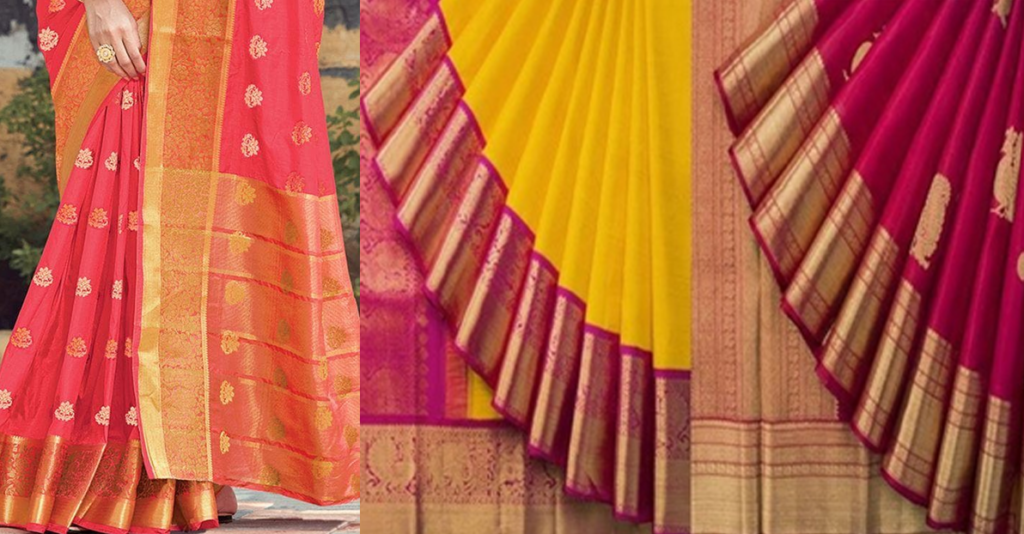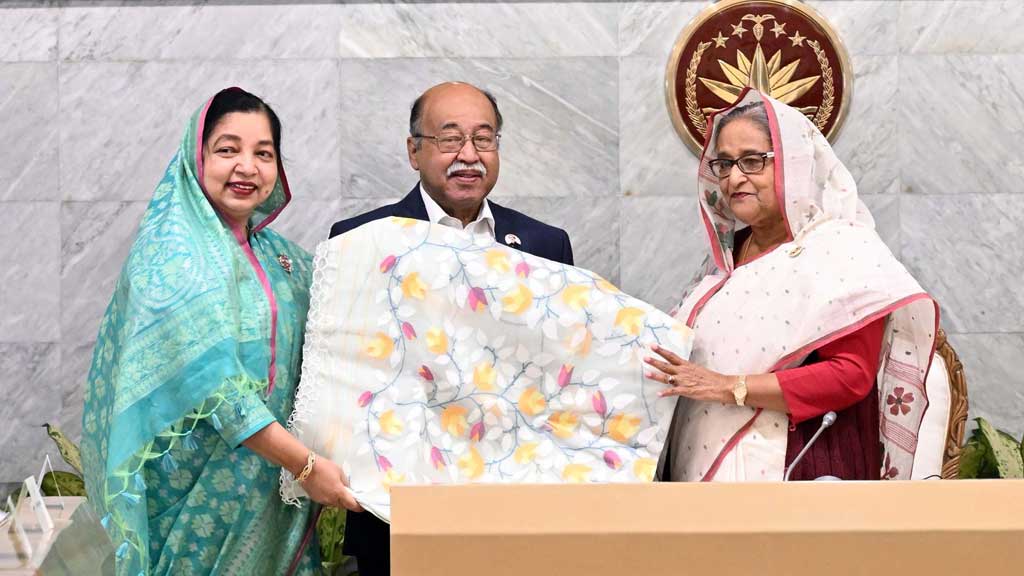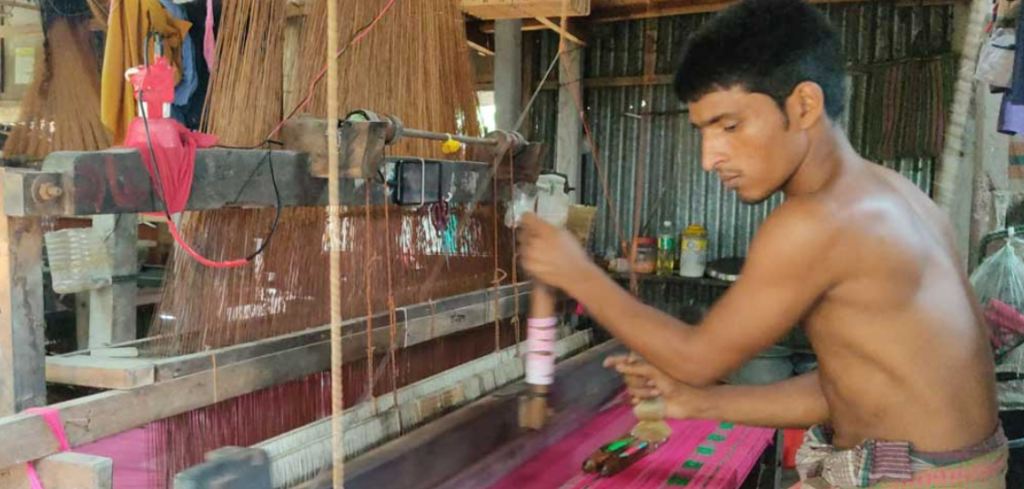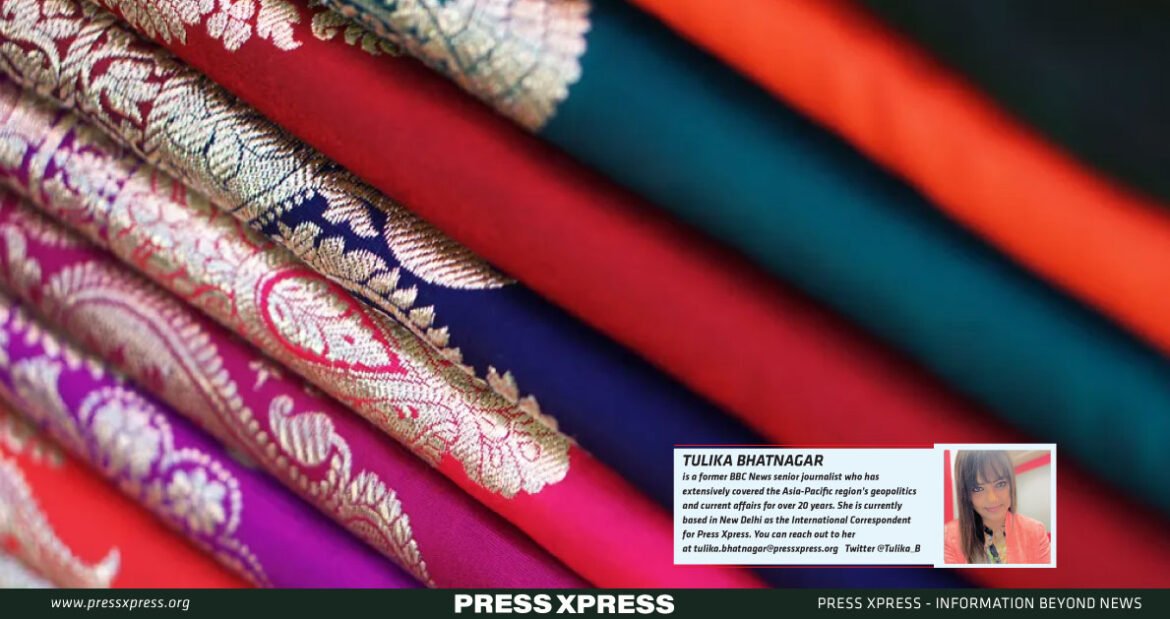The turf war between India and Bangladesh over the origins of the famed Tangail saree is far from over as Dhaka has now enlisted an Indian law firm to fight the battle legally.
Delhi-based Mason & Associates specialises in intellectual property rights, and trademark & design, besides copyright, media, and internet laws.
You can also read: Bangladesh’s Garment Sector: Championing Labor Rights for Sustainable Growth
The move comes after months of deliberations between the officials of the two countries, over claims of GI tag registration for the Tangail saree.
In every saree, a special story

The Tangail saree is a unique handwoven saree, each having its own story. It has become popular all over the world for its beautiful handweaving technique.
Weavers use an extremely fine yarn and a special type of thread, and every portion of the saree is weaved and designed by hand.
Weaving is done on a handloom by traversing the longitudinal threads (warp) with the horizontal threads (weft).
One of its exceptional features is the edge, or “par” of the saree, which is made with special care with cotton, silky or and shiny threads. Motifs are spaced-out and dotted designs are woven intricately on a soft, silky fabric to make the saree look beautiful.
It takes 5 to 7 days to weave a single saree.
After the sari is woven, it is folded in a characteristic manner and tied with a piece of cloth known as “Swatch.”
From West Bengal or Tangail?
At first glance, it would make sense to say that the Tangail saree originated in, well, Tangail, which is a district in the central region of Bangladesh.
It had more than 60,000 looms, according to a survey conducted in 2013, and Tangail saree weaving was a popular occupation.
Despite facing challenges – a weaver in Bengal earns merely 700 Taka for a single saree – the saree enjoys the status of being a part of the cultural heritage for ages.

According to Raghunath Basak, who has been crafting Tangail saris for decades, “Initially, Tangail saris were regarded as taant saris. However, my ancestors moved from one place to another in search of a suitable climate to produce these saris, and eventually, they found the perfect weather in Tangail.”
“Thus, these taant saris came to be known as Tangail saris,” he was quoted as saying in an article published on The Daily Star website.
On the other hand, India’s West Bengal claims that the original Basak community weavers migrated from Tangail before India’s partition in 1947. They settled in West Bengal’s Purba Bardhaman district. Tangail sarees are also woven in the Nadia district.
Earlier, the Tangail saree was referred to as “Begum Bahar”, in which silk warp and cotton weft were used to create it.
Around 20,000 Tangail weavers in Bengal are involved in its production, according to a report by The Statesman.
The GI tag row
In January earlier this year, West Bengal’s Chief Minister announced her pleasure over the social media platform X, on her state receiving the GI tag for the Tangail saree.
She wrote, “Three handloom saree items of West Bengal, namely Tangail of Nadia and Purba Bardhaman, and Korial & Garad of Murshidabad and Birbhum, have been registered and recognized as GI products. I congratulate the artisans for their skills and achievements. We are proud of them. Our congratulations to them!!”
Since then, it has stirred up an intense debate on social media as well as between the artisans of the two countries – Bengalis on both sides of the border claim the versatile Tangail saree as their own.
In Bangladesh, which is renowned worldwide for its textile industry, those involved in the Tangail saree business say that the handloom sarees have been the bearers of history and tradition for about 200 years.
“It is true that after partition in 1947 and then again in 1971, weavers from Tangail relocated to India,” says Md Fakhrul, president of Tangail Central Cooperative Artisans Welfare Association Limited, in Dhaka.
But GI tag is a geographical indication tag, argues researcher and writer Pavel Partha in The Business Standard. “The most important thing for GI is geology or a geographical location… the debate should be about geography. Tangail motifs woven elsewhere will not make it Tangail saree. You can’t take the Louhajang River to India or bring Nadia or Fulia to Bangladesh,” he says.
The weavers can take their skills and memories, but can you take the Louhajang River’s water, or the weather or the soil, when you relocate, he questions.
“It is a matter of great regret that India has received the GI tag, but all is not lost yet and we can still get the GI tag,” according to President of the National Crafts Council of Bangladesh (NCCB), Chandra Shekhar Saha.
PM Sheikh Hasina seen endorsing Tangail saree
Local dailies have reported that since the news of West Bengal being awarded the GI tag for Tangail saree came to light, Prime Minister Sheikh Hasina has also taken to wearing mostly Tangail sarees in her public appearances.

“For the last couple of days, I wore a Tangail saree to show that it is ours. No one else can take it,” she said. In a press conference about her overseas visit.
In response, Bangladesh took steps to secure the intellectual property rights for this traditional attire.
In February, the Tangail District Administration filed for a GI certificate, which was subsequently granted by the Department of Patent, Design, and Trademarks. Hasina later received the GI certificates for three iconic Bangladeshi products, including the Tangail saree.
Matter far from over
The matter is far from over with Dhaka now appointing Indian lawyers to take the fight forward.
Bangladesh’s Ministry of Industry has disclosed the information in a written statement to the High Court bench led by Justice Muhammad Khurshid Alam Sarkar.
It has also submitted a list of hundreds of GI products from different regions of Bangladesh to the court.
These include 33 products from 64 districts, which already have the GI tag as well as over 100 products, which await the GI tag registration.
The country’s Supreme Court lawyer Sarowat Siraj Shukla has in fact claimed that of the 500 GI tagged goods registered in India, at least 21 are fit to be registered as GI tag goods of Bangladesh.
Tangail handloom industry
Bangladesh’s Tangail has a declining cottage handloom industry.
According to data published in a report by Textile Focus, the looms are mostly installed in people’s houses, with 72% of the installed looms having a small unit size of only five looms. Units with six to 10 looms are about 11% and larger units with 11-20 looms are only 6% of the total. Then there are some small factories, which have units with 21 onward looms.
Now, studies done by the Ministry of Industries have shown the decline in the industry over the years.
In 1992, Tangail had over 100,000 handlooms and 150,000 weavers. In 2008, this reduced to 37,222 handlooms and 70,000 weavers. While in 2013, the number of looms in Tangail reduced to 60,000.
Overall, in Bangladesh, the Tangail handloom industry employs about 325,000 weavers, owners, and traders.
In contrast, in West Bengal, handloom weaving remains a major occupation in rural areas. There are more than 3.5 lakh handlooms in the eastern state of India, as per records of the state Directorate of Textiles. There are about 20,000 weavers engaged in this profession.

One of the weavers, Haripada Basak, living in Nadia in West Bengal, is a descendant of the original “Basak” weaver community, who was born and raised in “East Bengal”. He told BBC Bangla that Tangail was a subdivision of Mymensingh district in late 19th century British India. “In or around 1850, two villages named Dhamrai and Chowhatt in Tangail were inhabited by some descendants of muslin weavers. Some also settled in other nearby villages of Santosh, Kartia, and Delduar. This was the time when zamindari system was falling. All the people in all of these villages of Tangail used to weave sarees in their homes – so altogether, the term “Tangail Sarees” came into practice.”
So far, the outrage and emotions connected with Tangail saree refuse to cool down in either West Bengal or Bangladesh, and with the legal course action in due process, it remains to be seen how GI-tag sensitivity will hold in the future for products of both the countries, who cannot ignore their shared past.


